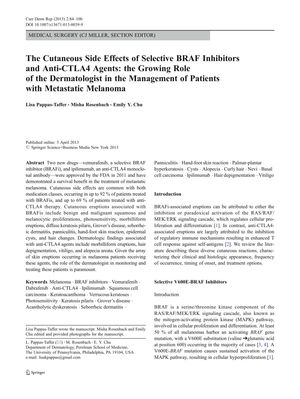The Cutaneous Side Effects of Selective BRAF Inhibitors and Anti-CTLA4 Agents: The Growing Role of the Dermatologist in the Management of Patients with Metastatic Melanoma
April 2013
in “
Current Dermatology Reports
”

TLDR Dermatologists are crucial for managing skin side effects in metastatic melanoma patients using vemurafenib and ipilimumab.
Two new drugs, vemurafenib (a selective BRAF inhibitor) and ipilimumab (an anti-CTLA4 monoclonal antibody), were approved by the FDA in 2011 and showed a survival benefit for metastatic melanoma patients. However, cutaneous side effects were common, affecting up to 92% of patients on BRAF inhibitors and up to 69% on anti-CTLA4 therapy. BRAF inhibitors caused various skin issues, including benign and malignant proliferations, photosensitivity, and hair changes, while anti-CTLA4 agents led to morbilliform eruptions, hair depigmentation, vitiligo, and alopecia areata. The diverse skin reactions necessitated a significant role for dermatologists in managing these patients.


